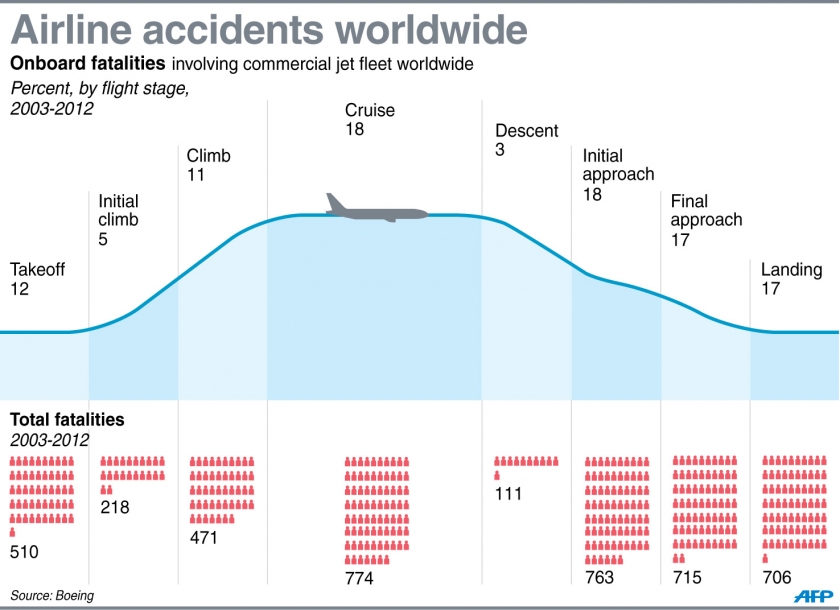The Malay Mail Online
March 13, 2014
KUALA LUMPUR, March 13 — A Chinese satellite hunting for the missing Malaysian jet detected three floating objects at sea along Flight 370’s intended route, the latest lead for investigators on the sixth day of a multi-nation search.
Images showed the pieces were as large as 24 metres by 22 metres, China’s State Administration of Science, Technology and Industry for National Defense said on its website. The pictures were taken on March 9, the day after the Boeing Co. 777-200 vanished while flying to Beijing from Kuala Lumpur. Malaysian Airline System Bhd. is verifying the data with the search and rescue team, said Lincoln Lee, a spokesman.
“People will be watching closely today,” said Jeff Walker, an aviation security consultant at JKG Global Group in Sydney. “The Chinese have very good equipment, so let’s wait and see if it’s the wreckage.”
China’s report, which placed the location near the confluence of the South China Sea and Gulf of Thailand, follows other leads that haven’t panned out so far. A dozen nations have been scouring the ocean and land with at least 42 ships and 39 aircraft for the plane carrying 239 passengers and crew.
China will keep working to “optimize the image areas, analyze data and continue to search for the missing Malaysian Airline flight according to the developments,” the administration said on its website.
Floating Objects
The smaller “suspected floating objects” measured 13 by 18 metres and 14 by 19 metres, according to the website. The satellite found the items in a radius of 20 kilometres around a point of 105.63º east longitude,6.7º north latitude, according to the site.
The -200 version of the 777, Boeing’s biggest twin-engine model, is 64 metres long and has a 61-metre wingspan, according to the company’s website.
The National Geospatial-Intelligence Agency is supporting the Department of Defense to find the missing aircraft, said spokesman Donald Kerr in an e-mailed statement. DoD is following up on all leads on the potential path of the aircraft, and is assisting US Pacific Command in their wide area search for debris fields.
Boeing said it already has investigators on site to assist the US National Transportation Safety Board. These teams would probably include 777 structures experts who can quickly identify crucial aircraft components, said John Purvis, a retired accident investigator who headed Boeing’s investigations unit for much of the 1980s and 1990s.
Soda Cans
Miles Kotay, a Boeing spokesman, wouldn’t say whether the world’s largest planemaker is reviewing the satellite imagery to determine whether the pieces came from the Malaysian Air jet.
“While we stand ready to assist investigators as needed, we do not comment on specifics,” Kotay said in an email.
Air patrols resumed at daybreak today after a multinational flotilla searched overnight, and China’s satellite photos put the waters north and east of Malaysia back as a central focus of the hunt for the missing 777.
The relatively shallow waters of the Gulf of Thailand should make it easier to locate the large pieces, which are probably no longer floating on the surface, said Purvis. Ships equipped with special sensors will be listening for pulses emitted by “pingers,” about the size of soda cans, attached to the so-called black boxes.
Pingers

“They’ve got 25 days left on their 30-day pingers,” said Purvis, who was involved in search and recovery efforts of TWA flight 800, the Pan Am crash in Lockerbie, Scotland and other disasters.
During probes of aircraft that ditched in the sea, Boeing personnel frequently head out on ships and barges searching for fragments of the missing aircraft, Purvis said. They can quickly tell if structures discovered by subsurface cameras would be critical to the investigation and worth the cost of hauling to the surface.
Flight 370’s route took it over the Gulf of Thailand, where the plane was approaching Vietnamese airspace when controllers lost contact. Signals from the jet’s transponder, a beacon that helps increase the plane’s visibility on radar screens, also ended then.
A Vietnamese search crew came up empty yesterday after searching the Vung Tau area in the southeast in response to a tip from an oil-rig worker who reported what looked to be a plane on fire. That was the area where a plane reported metal debris earlier this week, according to Vietnam’s Civil Aviation Authority.
Various Theories
The absence of wreckage has kept alive various theories about the plane’s disappearance, from an accident to hijacking to sabotage. The ships and aircraft are scouring waters on both sides of Peninsular Malaysia.
While the Gulf of Thailand initially took primacy in the hunt because of Flight 370’s last known position,Malaysia expanded the search this week to the Malacca Strait. Yesterday, Malaysia sought help from U.S. investigators in interpreting an unexplained radar blip detected over the strait, far from the jet’s route.
China, whose 153 citizens were the most of any nationality on the plane, had prodded Malaysia to conduct an immediate investigation into whether Flight 370 changed course, Qin Gang, a foreign ministry spokesman, said yesterday in a statement.
“This is unprecedented, what we are going through,” Acting Transport Minister Datuk Seri Hishammuddin Hussein told reporters yesterday in Kuala Lumpur.
“Coordinating so many countries together is not something that is easy.” — Bloomberg

#1 by PRmaju on Thursday, 13 March 2014 - 10:47 am
Now everyone should question why the Chinese govt took so long to release this importnat clue.
#2 by yhsiew on Thursday, 13 March 2014 - 11:21 am
Chinese satellites “have found SMOKE and floating objects” but cannot confirm this is related to the missing aircraft.